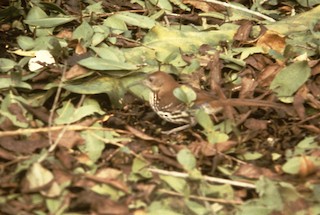Cozumel Thrasher Toxostoma guttatum Scientific name definitions
- CR Critically Endangered
- Names (22)
- Monotypic
Text last updated March 30, 2015
Sign in to see your badges
Species names in all available languages
| Language | Common name |
|---|---|
| Bulgarian | Козумелски кривоклюн присмехулник |
| Catalan | mim becut de Cozumel |
| Croatian | kozumelski raznopojac |
| Dutch | Cozumelspotlijster |
| English | Cozumel Thrasher |
| English (United States) | Cozumel Thrasher |
| Estonian | cozumeli pilalind |
| French | Moqueur de Cozumel |
| French (Canada) | Moqueur de Cozumel |
| German | Cozumelspottdrossel |
| Japanese | コスメルツグミモドキ |
| Norwegian | cozumelspottefugl |
| Polish | przedrzeźniacz dwupaskowy |
| Russian | Косумельский пересмешник |
| Serbian | Raznopojac sa ostrva Kozumel |
| Slovak | drozdec škvrnitý |
| Spanish | Cuitlacoche de Cozumel |
| Spanish (Mexico) | Cuicacoche de Isla Cozumel |
| Spanish (Spain) | Cuitlacoche de Cozumel |
| Swedish | cozumelhärmtrast |
| Turkish | Kozumel Çöpçüsü |
| Ukrainian | Тремблер козумельський |
Toxostoma guttatum (Ridgway, 1885)
Definitions
- TOXOSTOMA
- guttatum / guttatus
The Key to Scientific Names
Legend Overview
Introduction
Currently treated as Critically Endangered and endemic to Cozumel Island, off Mexico, where it was formerly fairly common to common, the Cozumel Thrasher became rare immediately after Hurricane Gilbert in September 1988. Only a few sightings have been noted since Hurricane Roxanne in 1995, the most recent being four observations of what is presumed to have been the same individual during surveys in 2004, and a single possible sighting in 2006, following two further devastating hurricanes in 2005. The Cozumel Thrasher is generally similar in plumage to the North American Brown Thrasher (Toxostoma rufum), having a long, decurved bill, rich chestnut-brown upperparts with two white wingbars, a pale supercilium, and white underparts heavily streaked black.
Field Identification
Systematics History
Subspecies
Distribution
Cozumel I, off NE Yucatán Peninsula (Mexico).
Habitat
Movement
Diet and Foraging
Sounds and Vocal Behavior
Breeding
Conservation Status
CRITICALLY ENDANGERED. Restricted-range species: present in Cozumel Island EBA. Very rare, with very few recent sightings. Formerly common to abundant, with population of up 10,000 individuals estimated in mid-20th century. Numbers drastically reduced following a very severe hurricane in 1988, and only three individuals found (all mist-netted) during ensuing seven years; after another damaging hurricane, in 1995, this species not recorded at all in annual surveys, and feared extinct by some. In Jun 2004, however, a single individual was discovered, the first for almost nine years. The last credible sighting was in 2006 BirdLife International (2015) Species factsheet: Toxostoma guttatum. Downloaded from http://www.birdlife.org on 30/03/2015. . Although the two hurricanes assumed responsible for the species’ demise, Cozumel I must have suffered similar meteorological phenomena at relatively frequent intervals prior to 1988; it could be expected to have evolved means of surviving the huge damage wrought by such events. Was earlier reported as inhabiting scrubby woodland and dense undergrowth, and edges of tropical forest, but the three individuals found in 1994 and 1995 were well away from scrub (two in deciduous forest, one in semi-deciduous forest). Thorough investigation of this species’ ecology may help to provide further explanation for its exceedingly rapid decline. Four other Cozumel endemic bird taxa have similarly declined during the same period (1). The role of introduced predators has not been quantified; Boa constrictors (Boa constrictor) appear to have been introduced on the island in 1971 (2). It is probably the mimid at greatest risk of imminent extinction. Considered nationally Endangered in Mexico (3).

- Year-round
- Migration
- Breeding
- Non-Breeding









































